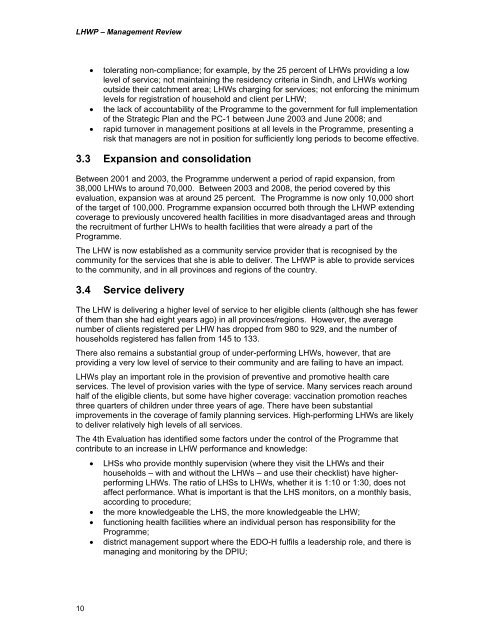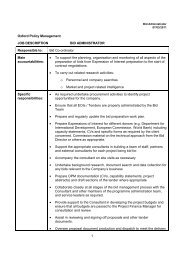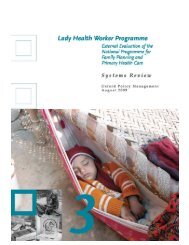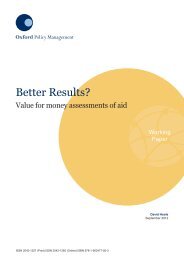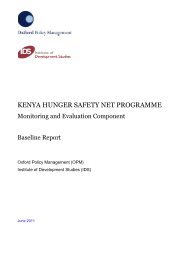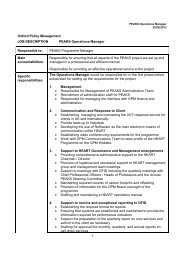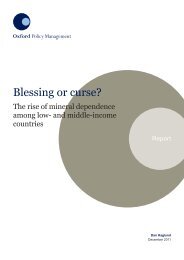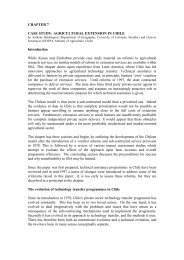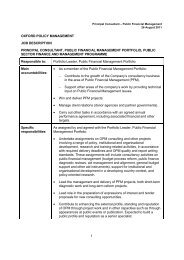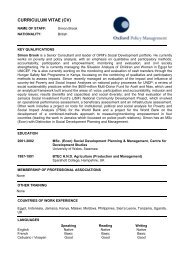LHW Management Review - Oxford Policy Management
LHW Management Review - Oxford Policy Management
LHW Management Review - Oxford Policy Management
Create successful ePaper yourself
Turn your PDF publications into a flip-book with our unique Google optimized e-Paper software.
<strong>LHW</strong>P – <strong>Management</strong> <strong>Review</strong><br />
• tolerating non-compliance; for example, by the 25 percent of <strong>LHW</strong>s providing a low<br />
level of service; not maintaining the residency criteria in Sindh, and <strong>LHW</strong>s working<br />
outside their catchment area; <strong>LHW</strong>s charging for services; not enforcing the minimum<br />
levels for registration of household and client per <strong>LHW</strong>;<br />
• the lack of accountability of the Programme to the government for full implementation<br />
of the Strategic Plan and the PC-1 between June 2003 and June 2008; and<br />
• rapid turnover in management positions at all levels in the Programme, presenting a<br />
risk that managers are not in position for sufficiently long periods to become effective.<br />
3.3 Expansion and consolidation<br />
Between 2001 and 2003, the Programme underwent a period of rapid expansion, from<br />
38,000 <strong>LHW</strong>s to around 70,000. Between 2003 and 2008, the period covered by this<br />
evaluation, expansion was at around 25 percent. The Programme is now only 10,000 short<br />
of the target of 100,000. Programme expansion occurred both through the <strong>LHW</strong>P extending<br />
coverage to previously uncovered health facilities in more disadvantaged areas and through<br />
the recruitment of further <strong>LHW</strong>s to health facilities that were already a part of the<br />
Programme.<br />
The <strong>LHW</strong> is now established as a community service provider that is recognised by the<br />
community for the services that she is able to deliver. The <strong>LHW</strong>P is able to provide services<br />
to the community, and in all provinces and regions of the country.<br />
3.4 Service delivery<br />
The <strong>LHW</strong> is delivering a higher level of service to her eligible clients (although she has fewer<br />
of them than she had eight years ago) in all provinces/regions. However, the average<br />
number of clients registered per <strong>LHW</strong> has dropped from 980 to 929, and the number of<br />
households registered has fallen from 145 to 133.<br />
There also remains a substantial group of under-performing <strong>LHW</strong>s, however, that are<br />
providing a very low level of service to their community and are failing to have an impact.<br />
<strong>LHW</strong>s play an important role in the provision of preventive and promotive health care<br />
services. The level of provision varies with the type of service. Many services reach around<br />
half of the eligible clients, but some have higher coverage: vaccination promotion reaches<br />
three quarters of children under three years of age. There have been substantial<br />
improvements in the coverage of family planning services. High-performing <strong>LHW</strong>s are likely<br />
to deliver relatively high levels of all services.<br />
The 4th Evaluation has identified some factors under the control of the Programme that<br />
contribute to an increase in <strong>LHW</strong> performance and knowledge:<br />
• LHSs who provide monthly supervision (where they visit the <strong>LHW</strong>s and their<br />
households – with and without the <strong>LHW</strong>s – and use their checklist) have higherperforming<br />
<strong>LHW</strong>s. The ratio of LHSs to <strong>LHW</strong>s, whether it is 1:10 or 1:30, does not<br />
affect performance. What is important is that the LHS monitors, on a monthly basis,<br />
according to procedure;<br />
• the more knowledgeable the LHS, the more knowledgeable the <strong>LHW</strong>;<br />
• functioning health facilities where an individual person has responsibility for the<br />
Programme;<br />
• district management support where the EDO-H fulfils a leadership role, and there is<br />
managing and monitoring by the DPIU;<br />
10


